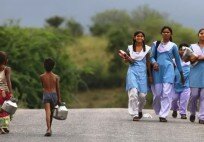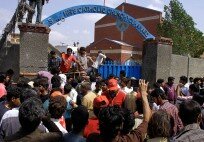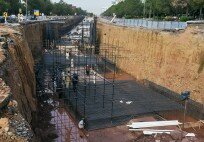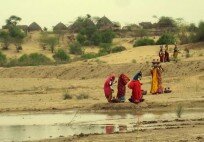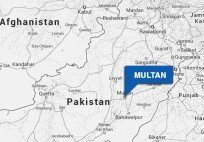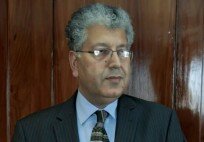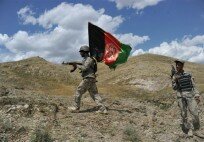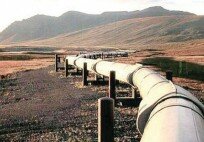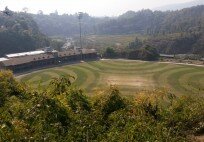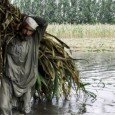By Khalid Mustafa –
Even as the world sounds alaram over ‘water stressed’ Pakistan’s future none seem pushed at home about what lies in store
Given Pakistan’s astonishingly rapid depletion of water resources, it is incredulous so little attention is paid to it. It’s almost as if a freight train is hurtling towards a dead end — and at speed. The per capita water availability is dwindling every single day, putting food security at risk. Not that the authorities could care less. Consider this: The per capita water availability in Pakistan has slid by over 406 per cent — from 5,260 cubic meters in 1951 to 1,038 cubic meters in 2010 — leaving it only marginally above the 1,000 cubic meters per person threshold value under the global standard.
“And if the status quo continues, then by 2020, water availability in Pakistan would further plummet to 877 cubic meters per annum — and to an alarming level of 575 cubic feet in 2050,” reveals the last document of Wapda on water availability vis-à-vis the population a copy of which is exclusively available with Pique. What is more shocking is that Pakistan’s storage capacity is just 30 days whereas India can store water for 120-220 days; Egypt has 1000 days water storage capacity only on Nile river; America 900 days on Colorado river; Australia 600 and; South Africa 500 days on Orange River.
Agriculture productivity in Pakistan in the wake of just 30-day water storage capacity has also considerably reduced because of water scarcity and its contribution towards the GDP has lowered by 21.8 per cent of the GDP.” The document says that underground water is fast depleting as the annual extraction of water has swelled up to 51 million-acre feet of water. Pakistan’s geographical area, the document shows, is 196.7 million acres (MA) out of which an area of 72.7 million acre is cultivable for agriculture. Some 52.4 million acres of this land is cultivated (irrigated and barani). The area under irrigation is 48.2 million acres. This shows that 20.3 million acres of land is still needed to be irrigated, which can only be done if Pakistan has the capacity to regulate water releases by building more reservoirs. If Pakistan has more dams, it can easily irrigate additional land of 20.3 million acres, ensuring food security. Sindh has 3.5 million acres of land which can be brought under cultivation; Punjab 3.9MA; Khyber-Pakhtunkhwa 3.1MA; and Balochistan 9.8 million acres of land, which if irrigated would be a harbinger of prosperous Pakistan.
“Pakistan’s water storage capacity has eroded by 27% which is almost equal to one full Mangla dam. It is projected to go up to 37% by 2025”
In 1951, Pakistan’s population was just 34 million, which increased to 173 million but no census has been carried out since 1998, which, too, was disputed. It has continued to grow at a rate of 2.3% during the interim. Unofficial reports suggest it is now 192 million. However, in the graph prepared by Wapda on water availability vis-à-vis the projected population in 2020, water availability would stand at 877 cubic meters with the numbers at 204 million and; in 2030, it would be 751 cubic meters for a population at 238 million. In 2050, water availability would be further reduced to 575 cubic meters with the numbers at 273 million. This shows that growthin population and increasing stress on water resources in the wake of faulty water policies in the past has compounded the issues to an unimaginable level.
The document reveals that Pakistan has also lost its capacity to store water by 27 percent — from 16.28MAF to 11.91MAF — because of sedimentation as 4.99MAF gets stored in the Mangla Dam alone. It says Tarbela was built in 1974 with a storage capacity of 9.69MAF, which has reduced in 2011 by 31 percent to 6.77MAF. Mangla dam, which was built in 1967 with a capacity to store 5.87 million acre feet of water has slid by 15 percent to 4.99MAF. Likewise, Chashma barrage was built in 1971 with an ability to store water up to 0.72MAF but owing to sedimentation, its storage capacity has dwindled by 65 percent to just 0.25MAF.
In toto, Pakistan’s water storage capacity has eroded by 27 percent which is almost equal to one full Mangla dam, whose existing capacity to store water is 4.99MAF. The Wapda document also predicts that Pakistan will lose more capacity to store water — by up to 37 percent (5.95MAF) in 2025 — if water managers of the country did not rectify policies and built dams. But they have already failed miserably to improve water storage capacity and increase per capita availability. Continuing on this downward spiral would lead to food insecurity in the years to come. Consider this stark statistic: the per capita storage capacity in the U.S. stands at 6,150 cubic meters while in Pakistan it is just 132 cubic meters.
The World Bank and Asian Development Bank have already termed Pakistan as one of the most “water stressed” countries around the globe, which is likely to face an acute shortage over the next half a decade. Water supply in Pakistan is likely to reduce to 800 cubic meters per capita by 2020, World Bank reports say. According to Falkenmark Water Stress Indicator, a country or region is said to experience “water stress” when annual water supplies drop below 1,700 cubic meters per person per year. When water supplies drop below 1,000 cubic meters per person per year, a country faces “water scarcity”. The report also pinpoints that in Pakistan, water is excessively wasted in houses, offices, markets and factories. Fresh and drinking water is used for washing, gardening and other non-drinkable purposes. “Besides wastage, the burgeoning population, climate change, lack of reservoirs, and manipulation of Jhelum and Chenab rivers by India are other key factors squeezing water availability in Pakistan.”
“Pakistan has failed miserably to improve the water storage capacity and increase per capita availability. Continuing on this downward spiral would lead to food insecurity in the years to come”
Moreover, the UN has placed Pakistan among the ‘water hotspots’ of Asia-Pacific region, saying the country is facing major threats of increasing water scarcity, high water utilisation, deteriorating water quality and climate change risk. Wapda member Syed Raghib Abbas Shah concedes they are up against it. “Yes, Pakistan’s water situation is deteriorating by the day and if the status quo holds Pakistan will be left to face unprecedented catastrophe in terms of touching the per capita water availability to its lowest ebb.” However, he said, if the government provides Wapda timely and speedy financial releases, then water situation could be improved to some extent. He said for various water projects, the sitting government in 2009-10 released finances amounting to Rs11.395 billion against the demand of Rs27.115 billion; in 2010-11, just Rs9.692 billion against Rs15.360 billion and; in 2011-12, against the demand of Rs138 billion, the government released only Rs14.707 billion.
“If the situation persists, the destiny of Pakistan will be nothing but drought, hunger, poverty and darkness.” Shah also pointed out that in 2010-11, about 54.5MAF water went down to the sea, which necessitates the building of huge dams on the Indus river to ensure regulated supply of water downstream Kotri to stop the waste. He said the government needs to become proactive for timely financial releases. It has committed for Mangla Dam Raising project in current fiscal 2012-13 only Rs6 billion against the demand of Rs8 billion; for Gomal Zam Dam Rs1.8 billion against Rs5 billion; for Satpara dam just Rs300 million against Rs500 million; Kurram Tangi dam Rs500 million against Rs5 billion; and for the current fiscal, the government has denied any allocation to Wapda for Mirani and Sabakzai dam.
Shah said Wapda had placed the demand of releasing Rs100 billion for 35 water projects but only Rs24.120 billion have been allocated. This is the main reason why Wapda has failed to increase water availability. About water releases downstream Kotri, Shah says it is necessary to stop the sea intrusion in coastal areas of Sindh for which 8.6 million acre feet of water downstream Kotri must be released in a year. However, every year they end up releasing 30-32 million acre feet of water on average just because of the fact that Pakistan has no more dams on Indus river, except Tarbela, which has lost 31 percent storage capacity due to silt. According to Arshad H. Abbasi, a renowned water expert, India at international forums always comes up with the stance that Pakistan is water rich as, on average, it releases 30-32MAF water downstream Kotri every year so if it makes the dam on Pakistan rivers, it is her (India’s) right as upper riparian particularly when the lower riparian is “busy wasting the water by diverting it to the sea”. Abbasi said Pakistan is one of the world’s most arid countries — over 75% of it receives less than 250mm rainfall annually and 20% of it less than 125mm. The population and economy are heavily dependent on an annual influx into Indus River System of about 154.88MAF of water mostly derived from snow and glacier melting.
“The global average contribution of per cubic meter of water to the GDP is US$ 8.6 whereas Pakistan’s contribution per cubic meter of water is less than half of that. On the other hand, in developed economies, the contribution of one cubic meter of water ranges from US$ 30-40.” In South East Asia, Abbasi says, the total water availability is 6,698 BCM i.e. 15.3% of the world water resources against 8.6% of world population (516 million). The per capita water availability is 12,980 m3. Some 90% of population lives under water stressed conditions — using 10% more water than fresh water available. He said in South Asia, the total water availability is 3,900 BCM/year, i.e. only 9% of the world’s water against 25% of world’s population. The per capita water availability is 2,600 m3/person. India is home to one-sixth of the world’s population and 1/25th water resources, i.e. 1,746 BCM with average of 1,740 m3/person but the variability is extensive. In a nutshell, water is life and if Pakistan does not address the issues of storing, managing and using it properly, it will only be inviting a catastrophe.
The writer is a journalist specializing in energy and water













